Minute Maid Park
Minute Maid Park, previously named The Ballpark at Union Station, Enron Field, and Astros Field, is a ballpark in Downtown Houston, Texas, United States, which opened in 2000 as the home stadium of the Houston Astros of Major League Baseball (MLB). The ballpark is Houston's first retractable-roofed stadium, and features a natural grass playing field. The ballpark was built as a replacement for the Astrodome, the first domed sports stadium ever built, which opened in 1965. It is named for beverage brand Minute Maid, a subsidiary of The Coca-Cola Company, which acquired naming rights in 2002 for $100 million over 30 years. As of 2016, Minute Maid Park has a seating capacity of 41,168, which includes 5,197 club seats and 63 luxury suites.
The Juice Box[1] | |
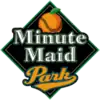 | |
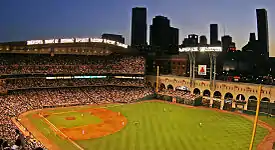 View of Minute Maid Park among Houston's Downtown skyline | |
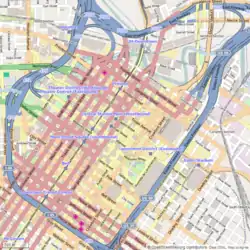 Minute Maid Park Location in Downtown Houston 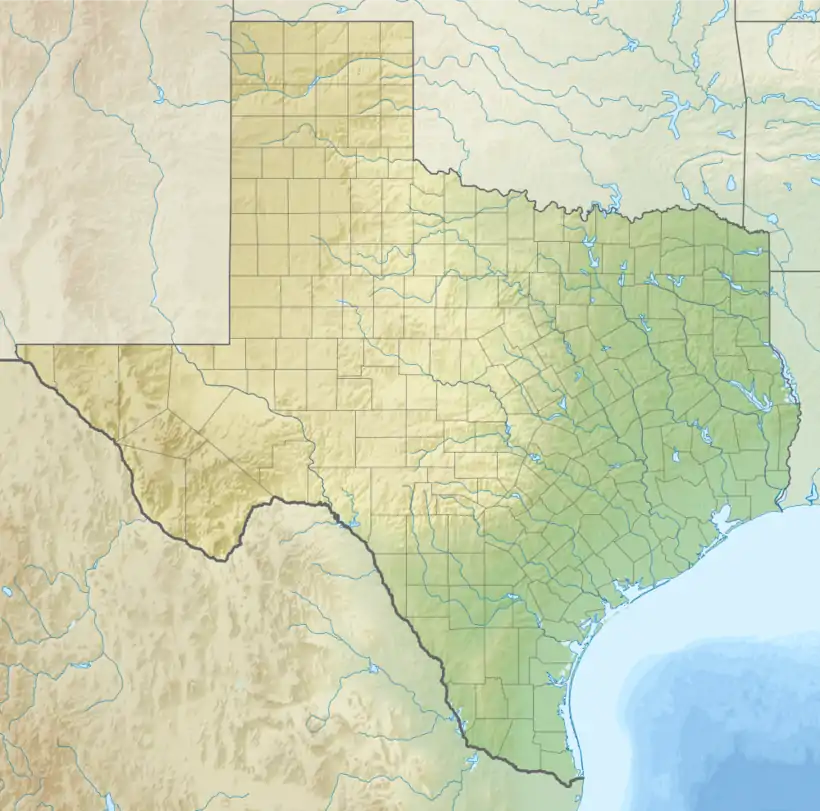 Minute Maid Park Location in Texas  Minute Maid Park Location in the United States | |
| Former names | The Ballpark at Union Station (2000) Enron Field (2000–2002) Astros Field (February–July 2002) |
|---|---|
| Address | 501 Crawford Street |
| Location | Houston, Texas |
| Coordinates | 29°45′25″N 95°21′20″W |
| Public transit | Convention District Station 3, 6, 11, 20, 30, 37, 48, 50, 77, 137, 163, 236, 255, 256, 257 |
| Parking | Estimated 25,000 total spots within walking distance |
| Owner | Harris County-Houston Sports Authority |
| Operator | Harris County-Houston Sports Authority |
| Capacity | 41,168 (2017–present)[2] 41,676 (2016)[3] 41,574 (2015)[4] 42,060 (2013–2014)[5] 40,981 (2012)[6] 40,963 (2011)[7] 40,976 (2006–2010)[8] 40,950 (2000–2005) |
| Record attendance | 44,203, September 26, 2001[9] |
| Field size | Left field – 315 feet (96.0 m) Left-center – 362 feet (110.3 m) Left-center (deep) – 404 feet (123.1 m)[10] Center field – 409 feet (124.7 m) Right-center (deep) 408 feet (124.4 m) Right-center – 373 feet (113.7 m) Right field – 326 feet (99.4 m) Backstop – 49 feet (15 m) 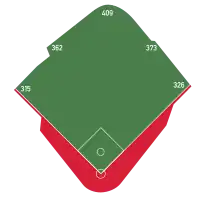 |
| Surface | Platinum TE Paspalum[11] |
| Scoreboard | 54 feet (16.5 m) high by 124 feet (37.8 m) wide |
| Construction | |
| Broke ground | November 1, 1997 |
| Opened | March 30, 2000 (Exhibition) April 7, 2000 (Regular Season) |
| Renovated | 2010 (Off season) 2017 (Off season)[12] |
| Construction cost | $250 million ($371 million in 2019 dollars[13]) |
| Architect | HOK Sport (now Populous) Molina & Associates |
| Project manager | Schindewolfe and Associates[14] |
| Structural engineer | Walter P Moore[14] |
| Services engineer | M-E Engineers, Inc. (Bowl)[15] Uni-Systems, Inc. (Roof)[14] |
| General contractor | Brown & Root/Barton Malow/Empire Joint Venture[14] |
| Tenants | |
| Houston Astros (MLB) (2000–present) | |
History
Union Station and pre-ballpark era
In 1909, during the time when West End Park was Houston's premier ballpark, the Houston Belt and Terminal Railway Company commissioned the design of a new union station for the city from New York City-based architects Warren and Wetmore. The location called for the demolition of several structures of Houston prominence. Horace Baldwin Rice's residence and Adath Yeshurun Congregation's synagogue among other structures were removed.[16]

With an original estimated cost of US$1 million, Union Station was constructed by the American Construction Company for an eventual total of five times that amount.[17] Exterior walls were constructed of granite, limestone, and terracotta, while the interior used an extensive amount of marble. It was completed and opened on March 1, 1911. At the time, Houston, with 17 railways, was considered the main railroad hub of the Southern United States.[18] This is also evident by the Seal of Houston, which prominently features a locomotive. Two more floors were added the following year.[19]
The station served as the main inter-city passenger terminal for Houston for over seven decades thereafter. Passenger rail declined greatly after World War II, and the last regularly-scheduled train, the Lone Star, moved its service to Houston's current Amtrak station on July 31, 1974. With this move, the building effectively became abandoned. On November 10, 1977, the building was added to the National Register of Historic Places by the National Park Service.
Planning and funding
In August 1995, Astros owner Drayton McLane, then leasing the Astrodome from Harris County, commented to the Houston Chronicle that he was not in the market for a new ballpark. In reference to Pittsburgh's Three Rivers Stadium and Cincinnati's Riverfront Stadium, McLane noted, "[...] I remember when those were built in the 1970s and those were as good a stadiums as there were. They were the most modern stadiums in the world, and now they're saying they're all bad. That they can't make a go of it without a new stadium. It helps, but there are other things involved."[20]
Later that year, Houston's NFL franchise and joint-tenant of the Astrodome, the Houston Oilers, announced they were leaving to Nashville, Tennessee in order to have a new stadium built for the team there. Citing a lack of adequate luxury boxes, in October, Astros Vice-President Bob McClaren claimed that renovations to the Astrodome would help increase revenue.[21] Drayton McLane pointed toward Astrodome renovations as necessary saying "It's 30 years old and not a lot of money has been spent to remodel it."[22] According to the organization, the team was in danger of being sold to a Virginia businessman who was expected to move the Astros to the Washington D.C. area because of poor revenue.
In June 1996, University of Houston alumnus, BMC Software and San Diego Padres owner, John J. Moores, who wanted to own the next NFL franchise in Houston, met with Texas State Senator Mario Gallegos, Jr., and other local Hispanic leaders in regard to the future of a football-only Astrodome and a new baseball-only ballpark in Downtown Houston.[23] Meanwhile, Harris County Judge Robert Eckels pieced together a plan to build a new ballpark next to the Astrodome in the Astrodomain. The Astros echoed the Astrodomain location sentiment because they believed construction time would be shorter.[24] Eckels, who convinced then Mayor Bob Lanier of the lack of viability for the ballpark in a downtown location, was quoted as saying, "They keep telling me about these miracles in other cities, but it doesn't work in Houston [...] If we are going to put this stadium some place, let's stick with a proven place."[25] This plan was considered to be nearly finalized when the Astros and Harris County agreed to a US$250 million county-funded stadium whose overrun costs would be funded by the Astros.[26]
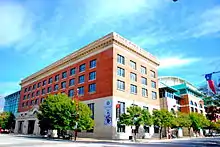
In August 1996, Houston's Union Station received a US$2 million grant from the Texas Transportation Commission for renovation in a separate project.[27] Plans for the new ballpark's location drastically changed by September mostly in response to Enron Chairman Kenneth Lay's input and pledge to substantially contribute to funding if placed downtown.[28] It was at this time where the Union Station location was proposed by Lay. Upon an agreement between all of the leadership entities, the idea of a retractable roof stadium was confirmed for the new ballpark. A November referendum was planned for Harris County residents to approve the deal.
The Harris County referendum that took place on November 5, 1996, to help fund the ballpark passed by a narrow margin of 51% to 49%.[29] In response to the referendum, during the 75th Texas Legislature Texas State Senator John Whitmire of Houston sponsored a bill supported by five of the six area Harris County senators that would create the Harris County-Houston Sports Authority.[30] With companion House Bill 92 authored by Houston-born Representative Kim Brimer voted upon and adopted by both chambers, the authorization for creation of a sports authority was approved.[31] It was signed into law by Governor George W. Bush on June 2, 1997.[32] The Harris County-Houston Sports Authority would assist in financing for the new ballpark as well as allow for renovation of the Astrodome by allowing for special county-wide taxation of rental cars, tickets, parking, and hotel use.
In June 1997, with the ability to create a sports authority signed into law, concurrent votes of the Harris County Commissioners' Court and the Houston City Council to establish the Harris County-Houston Sports Authority on effective September 1, 1997.[33] Its chairman and 12 other directors were jointly appointed by the Mayor of Houston and Harris County Judge. The institution remains in existence today.
The ballpark was named "Enron Field" after a $100 million, 30-year naming rights deal was made with Enron on April 7, 1999.[34]
Design and construction
Early stadium sketches from Kansas City-based HOK Sport (now Populous) using the working title "The Ballpark at Union Station" were released to the public on October 11, 1996, where Astros President Tal Smith was open about his suggestions for the stadium including the location of the flagpole in center field and a traditional dirt path from the pitcher's mound to home plate.[35][36] While the dirt path was not implemented, the flagpole idea became known as "Tal's Hill" and remained a signature feature of the ballpark until 2016.
The design of the new park integrated the former Union Station building's main concourse, reutilizing the space for a clubhouse, cafe, team store, and office space.[37] A large model train was also included within the park's design as an homage to the station.
In late 1997, it was announced that local Brown & Root would manage construction of the stadium, while Populous with Walter P. Moore would design it.[38] The electrification of Minute Maid Park's retractable roof was developed by VAHLE, Inc.[39]
Groundbreaking for The Ballpark at Union Station was on October 30, 1997.[40] Its groundbreaking ceremony was attended by Enron CEO Kenneth Lay, Houston Mayor Bob Lanier, Astros owner Drayton McLane, Harris County Judge Robert Eckles, Harris County Commissioner El Franco Lee, and Harris County-Houston Sports Authority Chairman Jack Rains.
Statues of longtime Astros players Jeff Bagwell and Craig Biggio are located in the exterior of the ballpark in a space known as The Plaza at Minute Maid Park. The two former teammates are depicted playing baseball with each other. The plaza also displays pennants for all Astros division & league championships, plus a World Series title, as well as several plaques to commemorate notable Astros and their achievements.
Opening and current use
The ballpark was first named "Enron Field" on April 7, 2000, with naming rights sold to the Houston energy and financial trading company in a 30-year, $100 million deal. However, Astros management faced a public relations problem when the energy corporation went bankrupt in 2001 due to a financial scandal. Quickly wanting to distance themselves from Enron, Astros ownership asked to prematurely end naming rights, but Enron refused.[41] On February 5, 2002, Astros ownership filed a motion with the court overseeing the company's bankruptcy to force Enron to make an immediate decision on the matter. By February 27, the two entities agreed to end the naming rights, and settled with the Astros paying $2.1 million to Enron. Without a naming rights agreement in place, the ballpark became officially known as "Astros Field".[42]
In June 2002, the Astros announced they had sold naming rights of the ballpark to locally based Coca-Cola subsidiary Minute Maid for $100 million over 30 years.[43] Its official name was then changed to "Minute Maid Park".
During its days as Enron Field, it was also dubbed "Ten-Run" or "Home Run" Field due to its cozy left-field dimensions. In keeping with this theme while paying homage to its current sponsor, the nickname "The Juice Box" is colloquially used today.[44] The dubbing of the park as an extreme hitter-friendly park has been called into question. The 2009 season saw the park ranked 24th out of 30 Major League parks in terms of runs scored in the park and ten other ballparks saw more home runs hit.[45] The long center-field and left-center-field dimensions (before the 2016-17 renovations) neutralized the park, and Minute Maid's batting park factor is consistently very near average. However, in 2014, it was ranked the 12th-most batter-friendly ballpark.[46]
Alterations
In 2004, the Astros launched Wi-Fi throughout the ballpark, allowing fans to use the Internet while attending a game for a fee.[47] In addition, the ballpark was the first major sports facility to use a separate video board exclusively for closed captioning for the hearing impaired of PA system and video board content, rather than appearing along the bottom of the main board.
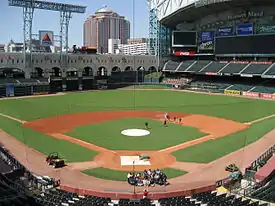
In 2006, the Chick-fil-A cows were unveiled on the foul poles, saying EAT MOR FOWL, and the cows have Astros caps on. If an Astros player hits the pole, all fans in attendance get a coupon for a free chicken sandwich from Chick-fil-A. Hunter Pence is the first and second Astros player to ever hit the left field "Fowl Pole" when he did it twice in the 2007 season. Ty Wigginton became the third Astro to hit the left field pole on September 16, 2007. Kazuo Matsui hit the right field foul pole on August 3, 2009, with a two-run homer in the sixth inning to beat the Giants. Carlos Lee hit the left field pole on July 28, 2010, giving the Astros an 8–1 win against the Cubs. Two days later, Jeff Keppinger hit the left field pole to help the Astros win, 5–0, against the Brewers.
After the 2008 season, the Astros' groundskeepers began installing 2.3 acres (9,300 m2) of a new turfgrass playing surface at Minute Maid Park.[48] The Astros also became one of the first to use the new Chemgrass, later known as AstroTurf after its first well-publicized use at the Houston Astrodome in 1966.
In honor of longtime Astros broadcaster Milo Hamilton, the City of Houston officially renamed a portion of the Ballpark District to the "Hall of Fame District", and the portion of Hamilton Avenue that runs within that district to "Milo Hamilton Way" on April 8, 2009.[49]
For the 2011 season, the park added a large Daktronics HD screen nicknamed "El Grande" replacing the original one in right field. At 54 feet (16 m) high and 124 feet (38 m) wide, it is the fourth largest scoreboard in Major League Baseball, behind T-Mobile Park (home of the Seattle Mariners), Progressive Field (home of the Cleveland Indians), and Kaufmann Stadium (home of the Kansas City Royals). The old screen was taken out and replaced by billboards. Additionally, a smaller HD screen was added on the far left field wall. The ring of advertisement screens around the park were replaced in favor of HD ribbon boards.[7]
After the Astros reverted to their original colors and logo in 2013, much of Minute Maid Park was repainted to navy and orange from brick red. Signs with the previous logo and colors were also replaced.[50] More than 4,500 US gallons (17,000 l) of paint were used and over 1,000 signs were replaced.
In June 2015 the Astros announced Tal's Hill would be removed in a major renovation project during the 2015-2016 offseason, to be replaced with additional seating, concessions, and escalators for fans.[51] This would result in center field dimensions of 436 feet (then the longest in MLB) being reduced to 409 feet. In addition, seating sections 256, 257, and 258 in the outfield mezzanine would be removed. However, the project had to be postponed due to the Astros' unexpected American League Wild Card championship and subsequent postseason appearance, along with the stadium's offseason event schedule.[52] The renovation was completed during the 2016-2017 offseason. The flagpoles became out of play.[53]
Major events
- On October 9, 2005, Minute Maid Park hosted the then-longest postseason game in Major League Baseball history, both in terms of time and number of innings. The Astros defeated the Atlanta Braves 7–6 in a game lasting 18 innings, which took 5 hours and 50 minutes to play.[54] The record was beaten by Game 3 of the 2018 World Series, which went 18 innings and lasted 7 hours and 20 minutes.
- On October 25, 2005, Minute Maid Park hosted the first World Series game ever played in Texas, and the longest World Series game ever played, which the Astros lost to the eventual World Series champion Chicago White Sox 7–5 in 14 innings; this game lasted 5 hours and 41 minutes.[55] The following night, the White Sox won their 3rd title—and first in 88 years—at Minute Maid Park.
- On September 30, 2007, in Craig Biggio's last game of his career, Minute Maid Park hit the highest attendance in its 8-year history by selling 43,823 tickets, 107% of its capacity.[56]
- On April 5, 2010, Opening Day of 2010, Minute Maid Park surpassed its highest attendance total once again by selling 43,836 tickets, 13 more tickets than its previous record.[57]
- The Astros transferred to the American League for the 2013 season, resulting in the designated hitter rule coming into effect at Minute Maid Park. The last pitcher to bat at an MLB game in Houston was Astros pitcher Bud Norris.
- In his third start as an Astro, pitcher Mike Fiers threw the stadium's first no-hitter in a 3–0 victory over the Los Angeles Dodgers on August 21, 2015.[58]
- In late October 2017 the Astros hosted three World Series games against the Los Angeles Dodgers. The Astros would go on to win the 2017 World series, winning 2 of 3 games in Houston and 2 of 4 games in Los Angeles.
- In late October 2019, the Astros hosted four games of the World Series versus the Washington Nationals. While the Astros won all three away games, they lost all four games played at Minute Maid Park.
- It was one of two hosts (Globe Life Field being the other) for the 2020 NLDS. Atlanta swept Miami 3–0 to advance to the NLCS.
Non-baseball events
Soccer
While primarily a baseball venue, Minute Maid Park can adequately host sports such as soccer and both codes of rugby. The venue can also play host to large-scale music concerts. It is not large enough to comfortably accommodate American football. However, the opening of BBVA Compass Stadium four blocks southeast on Texas Avenue for the MLS's Houston Dynamo in 2012 has effectively made its use for future soccer games moot.
Its debut as a soccer venue happened during the 2006 edition of the CONCACAF Champions Cup. The stadium hosted the first leg of the quarterfinal between Portmore United of Jamaica (the "home" team) and Club América of Mexico.[59]
| Date | Winning team | Result | Losing team | Tournament | Spectators |
|---|---|---|---|---|---|
| February 22, 2006 | 2–1 | 2006 CONCACAF Champions' Cup Quarterfinal | 12,988 |
Professional Wrestling
Minute Maid Park hosted the 2020 Royal Rumble on January 26, making it the first time it has hosted a WWE pay-per-view event.
Concerts
Paul McCartney, Jay-Z, Beyoncé, Taylor Swift, Nelly, Tim McGraw, Staind and Madonna have all performed at Minute Maid Park.
| Date | Artist | Opening act(s) | Tour / concert name | Attendance | Revenue | Notes |
|---|---|---|---|---|---|---|
| April 21, 2007 | Jimmy Buffett | Robert Earl Keen | Bama Breeze Tour | — | — | Sonny Landreth was a guest. Michael Utley was not at the show due to minor surgery. Mac McAnally filled in on keyboards.[60] |
| November 16, 2008 | Madonna | — | Sticky & Sweet Tour | 41,498 / 41,498 | $5,170,100 | |
| November 5, 2011 | Taylor Swift | Needtobreathe David Nail Adam Brand | Speak Now World Tour | 42,095 / 42,095 | $3,435,756 | Nelly was the special guest.[61] |
| November 14, 2012 | Paul McCartney | DJ Chris | On the Run Tour | 38,036 / 38,036 | $4,478,038 | |
| July 18, 2014 | Beyoncé Jay-Z | — | On the Run Tour | 40,103 / 40,103 | $5,235,438 | |
| September 9, 2015 | Taylor Swift | Vance Joy Shawn Mendes | The 1989 World Tour | 40,122 / 40,122 | $5,202,196 | Originally planned to take place on October 13, but was moved backwards to avoid any potential scheduling conflict with the Houston Astros potentially making the 2015 Major League Baseball postseason.[62] Wiz Khalifa was the special guest.[63] |
| June 15, 2018 | The Eagles | Chris Stapleton | North American Tour 2018 | — | — | |
| November 3, 2018 | Ed Sheeran | Snow Patrol Lauv | ÷ Tour | 39,354 / 39,354 | $3,985,595 | |
| May 22, 2020 | Kenny Chesney | Florida Georgia Line Michael Franti Spearhead | Chillaxification Tour | TBA | TBA | |
| August 1, 2020 | Green Day Fall Out Boy Weezer | The Interrupters | Hella Mega Tour | TBA | TBA |
TV
The nationally syndicated TV talk show Rachael Ray held a mass wedding at the park following Hurricane Ike for 40 couples who were unable to get married after a company they paid to hold the weddings went bankrupt. Comedian Jeffrey Ross served as best man for all 40 couples. The ceremony was aired as part of a special episode of the talk show on November 21, 2008.[64]
Other events

The stadium also is the host of the Houston College Classic college baseball tournament, part of the winter fan festival held in February. The tournament features local schools the University of Houston and Rice University every year, a pair of major conference schools, alternating between Big 12 members University of Texas at Austin, Texas Tech University, Baylor University and SEC member Texas A&M University, as well as two other teams from around the country.
On May 9, 2015, Canelo Alvarez fought James Kirkland in the first boxing match fought in the stadium. Alvarez defeated Kirkland via knockout in the third round.
The University of Houston–Downtown also holds their commencement ceremony in Minute Maid Park.[65]
Minute Maid Park hosted a cricket match on November 11, 2015, the second in a series of three Cricket All-Stars matches played by retired greats of the game.[66] Shane Warne's Warne's Warriors clinched the series 2–0. Keeping with the naming conventions from the previous match at Minute Maid Park, the ends were named after Nolan Ryan and José Cruz, two players that have their numbers retired by the Astros.
On January 30, 2017, the stadium hosted Super Bowl Opening Night for Super Bowl LI at nearby NRG Stadium.[67]
From 2017 until 2020, the park will host the final rounds of the Houston leg of the FIRST Championship. To avoid damaging the field while the Astros were in season, the competition fields were built on a stage over the infield dirt between first and third base.[68]
On January 26, 2020, the park hosted WWE's pay-per-view Royal Rumble, one of the promotion's four annual flagship professional wrestling events.[69]
Features

The largest entrance to the park is inside what was once Houston's Union Station, and the left-field side of the stadium features a railway as homage to the site's history. The train moves along an 800-foot (240 m) length of track on top of the length of the exterior wall beyond left field when the Astros take the field during the first inning, when an Astros player hits a home run, and when the Astros win a game. It is driven by Bobby Vásquez, who goes by the name Bobby Dynamite. The train is an upscaled replica of the General 4-4-0 and is pulled by a cable which is operated by the driver.[70] The engine's tender is filled with giant oranges in reference to Minute Maid's most famous product, orange juice. Upon a World Series win, as it did in 2017, Queen's We Are the Champions is played over the PA.

In dramatic contrast to the Astrodome, the most pitching-oriented stadium in Major League Baseball for most of its existence, Minute Maid Park is known for being particularly hitter-friendly down the lines, especially in left field where it is only 315 feet (96 m) to the Crawford Boxes, though the wall there is 19 feet (5.8 m) tall. In a challenge to home run hitters, former Astros owner Drayton McLane's office window, located in the old Union Station and directly above the Crawford Boxes, is made of glass and a sign below the window is marked 422 ft (135 m) from home plate.
There is a manually-operated out-of-town scoreboard in left, below the Crawford Boxes.
In contrast to the ease of hitting a home run to the Crawford Boxes, it was quite difficult to hit a ball out in center field, as the deep-center wall was 436 feet (133 m) from home plate and had held the top spot for active MLB ballparks for the deepest center field of any park in baseball.[71] Fielding is a challenge there as well, due to the 90-foot (27 m) wide center field incline called Tal's Hill, for former team president Tal Smith, an element taken from Crosley Field and other historic ballparks, and the flagpole in play, an element taken from Yankee Stadium before its remodeling in the mid-'70s and Tiger Stadium among others. Milwaukee Brewers player Richie Sexson once hit a ball off the flagpole. There was a mark there until the 2011 season, when the pole was repainted. The hill and the flagpole were scheduled to be removed following the 2015 season,[72] but remained in place due to an unexpected playoff run.[73] The hill and flagpole remained in place until the end of the 2016 season.[74]
The visiting team's bullpen is housed entirely in the exterior left field wall, next to the Crawford Boxes, making it one of the few bullpens in Major League ballparks to be completely indoors. Although windows in the outfield fence offer a view into and from the bullpen, its entrance is actually built into the side of the Crawford Boxes.
While Crosley Field's infamous left field terrace, which was half as steep (only 15°) as Tal's Hill (30°), was a natural feature of the site on which the park was located, Tal's Hill is purely decorative. Both features have been held in equal disdain by center fielders. This hill has caused some of the most replayed catches in recent baseball history, and plenty of controversy as well. Lance Berkman said, "If the ball rolls onto the hill, it's not steep enough to roll back, so you have to go get it. Then there's the chance of running into the flagpole that's on it and getting hurt." Fans started an online petition to remove the hill and flagpole, though the petition has since been discontinued. On June 4, 2015, the Astros announced that they would be removing Tal's Hill as part of a $15 million renovation for the 2016 season. The center field fence was to be moved in from 436 feet (133 m) (which from 2000 to 2016 was the longest in baseball) to 409 feet (125 m) from home plate, but the center field renovations were delayed until after the 2016 season, due at least in part to the 2015 playoffs cutting into planned construction time.[75]
The ballpark features 19,201 seats on the lower level,[76] 7,132 seats on the second level,[76] 880 seats on the suite level,[76] and 13,750 seats on the upper level.[76]
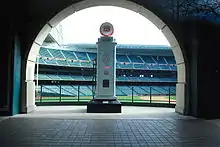
A concourse above Tal's Hill features the "Phillips 66 Home Run Porch" in left-center field that is over the field of play, and features a classic petrol pump that displays the total number of Astros home runs hit since the park opened.
The stadium can be fully air-conditioned when required.
Tal's Hill
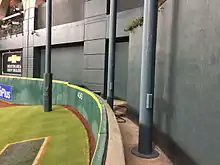
Tal's Hill, also called "The Grassy Knoll",[77][78] was a 90-foot (27 m)-wide-30 degree incline in the outfield at Minute Maid Park in Houston, Texas, United States.[79] It was created in 2000 when Enron Field (as Minute Maid Park was named at the time) opened with a flagpole on it.[80] In 2016, Tal's Hill was leveled in order for the Houston Astros to add a new seating area to center field in place of the hill.[81] It was named after former Astros President Tal Smith who proposed its inclusion.[82]
History
In 1996, when the Astros were designing a new stadium during a meeting at the Astrodome, owner Drayton McLane asked "What can we do to make this ballpark special?" Tal Smith responded by suggesting a hill and a pole in center field similar to the Cincinnati Reds' Crosley Field.[82] The project became known as "Tal's Hill" when architects Populous made designs to facilitate the inclusion of the hill.[82]
Some players nicknamed it "The Grassy Knoll".[83] The first catch made on Tal's Hill was made by the Atlanta Braves' Andruw Jones in 2000 after he had fallen over running up the hill on the previous play.[84] Catches on the Hill were viewed to be some of the toughest to make and a number of players fell over on it or ran into the pole.[85] Lance Berkman once said about it: "If the ball rolls onto the hill, it's not steep enough to roll back, so you have to go get it, then there's the chance of running into the flagpole that’s on it and getting hurt."[77]
In 2015, the Houston Astros announced that Tal's Hill would be removed as part of an organizational evaluation requested by owner Jim Crane.[86] It was to be replaced with a new seating area and concession stands.[87] The removal was scheduled for the end of the 2015 Major League Baseball season; however, the Astros reached the postseason, which delayed the work until after the 2016 season.[87] The groundbreaking on removal took place on October 10, 2016.[88] The removal of Tal's Hill was viewed as an example of variations in MLB ballparks being removed for financial gain and also in the pursuit of uniformity in MLB ballpark playing fields.[89]
Ground rules
Under the Minute Maid Park ground rules, both Tal's Hill and the flagpole were considered in play. If a ball hit the flagpole on the hill and stayed in the field of play, it was in play. If it went out of the field of play (over the fence), it was a home run.[90] The Hill was criticized numerous times owing to the incline having the potential to cause injury to fielders unused to it.[84] However, there was never an injury to any player in relation to Tal's Hill.[91]
Transportation access
Minute Maid Park is located in Downtown Houston in a centralized area of the city, and accessible via a short driving distance on Interstate 10 (Katy Freeway/East Freeway), Interstate 69 (Southwest Freeway/Eastex Freeway), and Interstate 45 (Gulf Freeway/North Freeway). Street parking, garage parking, and private lot parking are available, with an estimated 25,000 spots within walking distance to the ballpark. Taxi cabs and pedicabs are also commonly found near the surrounding ballpark area.
Public transportation allows for accessibility via bus or light rail service. The METRORail light rail system has a station located one block south of Minute Maid Park, Convention District Station, served by the Green and Purple lines. The Red Line also serves the ballpark at Preston Station, six blocks to the west.
Hurricane Harvey
In 2017, the park and the entire city suffered from the devastation of Hurricane Harvey, which flooded many parts of the city with several feet of rain over four days. The Astros reported that despite water entering into the service levels of the stadium, Minute Maid Park remained in "good condition" when the storm cleared out. The lingering effects of Harvey forced the Astros to move their series against the Texas Rangers to Tropicana Field in St. Petersburg, Florida.[92] The Astros returned to Houston on Friday, September 1 to help the initial recovery efforts. Minute Maid Park hosted the city's first post-Harvey sporting event, and the park's first double-header the next day in an interleague game against the New York Mets.
References
- Popik, Barry. "Juice Box (Minute Maid Park Nickname)". TheBigApple. Retrieved November 19, 2014.
- "2017 Houston Astros Media Guide" (PDF). Major League Baseball Advanced Media. February 14, 2017. p. 505. Retrieved February 17, 2017.
- "2016 Houston Astros Media Guide" (PDF). Major League Baseball Advanced Media. February 18, 2016. p. 500. Retrieved March 28, 2016.
- "2015 Houston Astros Media Guide" (PDF). Major League Baseball Advanced Media. February 23, 2015. p. 485. Retrieved March 6, 2015.
- "2013 Houston Astros Media Guide" (PDF). Major League Baseball Advanced Media. February 19, 2013. p. 452. Retrieved April 4, 2013.
- 2012 Houston Astros Media Guide
- Barron, David (April 7, 2005). "'El Grande' Video Scoreboard is Just One of Many Upgrades Found at Minute Maid". Houston Chronicle. Retrieved September 12, 2011.
- "#11 Houston Astros - Forbes.com". www.forbes.com. Retrieved November 8, 2018.
- "St. Louis Cardinals at Houston Astros Box Score, September 26, 2001 - Baseball-Reference.com". Baseball-Reference.com. Retrieved November 8, 2018.
- "Death of Houston's Tal's Hill Continues Demise Of Baseball's On-Field Oddities". Forbes. Retrieved February 22, 2017.
- "Platinum TE Installed in Minute Maid Park". www.sodfather.com. Retrieved November 8, 2018.
- Levine, Zachary (October 7, 2010). "Astros plan major upgrades to Minute Maid Park". Houston Chronicle. Retrieved October 7, 2010.
- Federal Reserve Bank of Minneapolis. "Consumer Price Index (estimate) 1800–". Retrieved January 1, 2020.
- "Enron Field Hits a Home Run - Modern Steel Construction" (PDF). Archived from the original (PDF) on May 8, 2013. Retrieved November 8, 2018.
- M-E Engineers, Inc. | Awards Archived 2013-01-28 at Archive.today
- Workers of the Writers Program of the Projects Administration in the State of Texas (1942). Houston: A History and Guide. The Anson Jones Press. p. 260. Retrieved December 18, 2013.CS1 maint: uses authors parameter (link)
- "Grand Station of Terminal Co". Magnolia Park News. September 19, 1909. p. 1.
- Farbar, Jerome Hammond (1913). Houston: Where Seventeen Railroads Meet the Sea. H. H. Tammen Company. Retrieved December 18, 2013.
- Marsh, Tom (1999). "Houston Union Station: The Great Hall Revealed". Gulf Coast Chapter NRHS. Archived from the original on December 19, 2013. Retrieved December 18, 2013.
- Hohlfield, Neil (August 27, 1995). "Home Improvement". Houston Chronicle. p. 17.
- Williams, John; Blount, Terry; Mason, Julie (October 20, 1995). "City Officials Pitch Idea of Ticket Drive to Keep Astros Here". Houston Chronicle. p. 1.
- JohnWilliams; Blount, Terry; Mason, Julie (October 26, 1995). "McLane Gives City Two Weeks". Houston Chronicle. p. 1.
- Williams, John (June 4, 1996). "Hispanics Want Downtown Stadium, Senator Says". Houston Chronicle. p. 20.
- Williams, John (June 5, 1996). "Astros Say Eckels Lags on Stadium/Team warns Delay Could Lead to Move". Houston Chronicle. p. 25.
- Williams, John (June 10, 1996). "Downtown at Bat/Not All Convinced Dome Area Best for New Baseball Stadium". Houston Chronicle. p. 1.
- Williams, John (August 30, 1996). "Astros Agree to Pick Up Stadium Overrun Costs". Houston Chronicle. p. 1.
- Feldstein, Dan (August 29, 1996). "Renovation Plans to Get Union Station Back on Tracks". Houston Chronicle. p. 36.
- Williams, John (September 13, 1996). "Astros Near Decision to Stay - If Downtown". Houston Chronicle. p. 1.
- Williams, John; Ackerman, Todd; Hanson, Eric; Mason (November 6, 1996). "County Stadium Referendum Passes by Narrow Margin". Houston Chronicle. p. 1.
- Hornaday, Sarah (March 6, 1997). "Stadium Bill". Galveston Daily News. p. 9.
- "Texas Senate Review". Harper Herald. June 3, 1997. p. 5.
- "HB 92, 75th Regular Session: Actions". Legislative Reference Library of Texas. Retrieved February 10, 2014.
- "About HCHSA: History". Harris County-Houston Sports Authority. Retrieved February 10, 2014.
- Babineck, Mark (April 8, 1999). "New Houston Ballpark Gets Corporate Tag". The Brownsville Herald. p. B1.
- Williams, John (October 12, 1996). "Early stadium sketches unveiled/Astros' Smith helping to create unique, asymmetrical design". Houston Chronicle. p. 29.
- "The Ballpark at Union Station". New Braunfels Herald-Zeitung. October 13, 1996. p. 16.
- "Houston's Old Union Station Was Incorporated into Minute Maid Park". Adapt + Reuse. May 15, 2020.
- Williams, John (December 3, 1997). "Deal close on stadium project manager". Houston Chronicle. p. 38.
- "Stadium Systems". VAHLE, Inc. Retrieved April 4, 2013.
- Koidin, Michelle (October 31, 1997). "Ground Broken for Astros' New Ballpark". Texas City Sun.
- "Striking Out Enron". Sports Illustrated. February 5, 2002. Retrieved June 22, 2014.
- Isidore, Chris (February 27, 2002). "Astros Strike Out Enron". Sports Illustrated. Retrieved June 22, 2014.
- Schepp, David (June 5, 2002). "Juicy New Name for Enron Stadium". BBC News. Retrieved June 22, 2014.
- "Minute Maid Park". ESPN. Retrieved June 24, 2009.
- "MLB Park Factors - 2010". ESPN. Retrieved April 4, 2013.
- "Ranking MLB's Most Hitter-Friendly Ballparks, by the Numbers". Retrieved April 20, 2016.
- "Minute Maid Park goes Wi-Fi". Broadcast Engineering. September 24, 2004. Retrieved April 4, 2013.
- Zaccardi, Nick (December 8, 2008). "Astros First to Use New Turfgrass Surface". Major League Baseball Advanced Media. Retrieved December 8, 2008.
- Footer, Alyson (April 8, 2009). "Milo Hamilton Way Unveiled in Houston". Major League Baseball Advanced Media. Retrieved June 23, 2014.
- Footer, Alyson (March 29, 2013). "Minute Maid Park gets fresh makeover". MLB.com. Retrieved June 23, 2014.
- "Astros announce exciting new concepts for Minute Maid Park" (Press release). June 4, 2015. Retrieved October 27, 2017.
- "Tal's Hill lives! Astros delay scheduled Minute Maid Park renovations". FOX Sports. October 15, 2015. Retrieved October 27, 2017.
- Young, Matt (October 10, 2016). "Astros break ground on removal of Tal's Hill". Houston Chronicle. Retrieved October 12, 2016.
- Ortiz, Jose De Jesus (October 10, 2005). "A Win Like No Other". Houston Chronicle. Retrieved October 10, 2005.
- Ortiz, Jose de Jesus (October 26, 2005). "Astros Lose Heartbreaker at Bitter End". Houston Chronicle. Retrieved October 26, 2005.
- Ortiz, Jose de Jesus (September 30, 2007). "Biggio Goes Out in Style As Astros Win". Houston Chronicle. Retrieved May 27, 2012.
- Fallas, Bernardo (April 20, 2010). "Astros Seeking to Fight Off Decline in Attendance". Houston Chronicle. Retrieved May 27, 2012.
- Ortiz, Jose de Jesus (August 21, 2015). "Astros' Mike Fiers tosses first no-hitter in Minute Maid Park history against Dodgers". Houston Chronicle. Retrieved August 22, 2015.
- Fallas, Bernardo (February 23, 2006). "Club América Finds Its Footing in Win / Mexican Team Produces Goals to Rally Past Portmore United". Houston Chronicle. Retrieved May 27, 2012.
- "Saturday, April 21st, 2007 – Houston, TX – Minute Maid Park » Jimmy Buffett World". www.buffettworld.com. Retrieved November 8, 2018.
- "Speak Now World Tour Guests". taylortalk.org. Retrieved June 6, 2015.
- "Astros' playoff chances force Taylor Swift to reschedule Minute Maid Park gig". Fox Sports. July 27, 2015. Retrieved July 30, 2014.
- Li, Shirley (September 10, 2015). "Taylor Swift performs 'See You Again' with Wiz Khalifa on 1989 tour". Entertainment Weekly. Retrieved September 10, 2015.
- Noonoo, Jemimah (November 3, 2008). "Rachael Ray Holds Mass Wedding in Houston". Houston Chronicle. Retrieved May 27, 2012.
- Commencement Archived 2015-04-20 at the Wayback Machine from University of Houston–Downtown, retrieved 14 May 2015
- "USA All-Stars tour gaining momentum". cricket.com.au. Retrieved November 9, 2015.
- Barron, David (November 17, 2016). "Super Bowl LI "Opening Night" at Minute Maid on Jan. 30". Houston Chronicle. Retrieved January 18, 2020.
- Felipe Aguirre (April 22, 2017). "FIRST Robotics Competition Worlds 2017 @ Minute Maid Park Houston TX Energy Institute High School". Retrieved November 8, 2018 – via YouTube.
- Barron, David. "WWE's Royal Rumble coming to Minute Maid Park in 2020". Houston Chron. Retrieved February 16, 2019.
- Lauber, Scott (October 14, 2017). "'A few steps from the top of the world': Riding the iconic train at Minute Maid Park". ESPN. Retrieved October 14, 2017.
- Weiner, Rick. "Ranking MLB's Most Hitter-Friendly Ballparks, by the Numbers". Retrieved November 8, 2018.
- "Level playing field: Astros to get rid of Tal's Hill". Retrieved September 16, 2016.
- "Too 'Tal' a task? Astros delay removal of CF Hill". Retrieved September 16, 2016.
- Pagels, Jim. "Death of Houston's Tal's Hill Continues Demise Of Baseball's On-Field Oddities". Retrieved September 16, 2016.
- "Astros delay renovations to Minute Maid; Tal's Hill lives another year". Ultimate Astros. Retrieved April 4, 2016.
- "Minute Maid Park Facts and Figures". Major League Baseball Advanced Media. Retrieved April 4, 2013.
- "Ballpark Breakdown: Betting Minute Maid Park". Covers.com. May 16, 2007. Retrieved March 3, 2017.
- "The last stand for Tal's Hill at Minute Maid Park". Vice. Retrieved March 3, 2017.
- Barron, David (June 4, 2015). "Astros to scrap Tal's Hill as part of $15 million ballpark redesign". Houston Chronicle. Retrieved March 3, 2017.
- "Houston Astros to get rid of Tal's Hill, flagpole after 2015 season". ESPN. June 4, 2015. Retrieved March 3, 2017.
- Axisa, Mike (October 12, 2016). "LOOK: Here's what Tal's Hill at Minute Maid Park looks like as it's being leveled". CBS. Retrieved March 3, 2017.
- Atkins, Hunter (September 27, 2016). "Tal's Hill, home to a generation of thrills and chills, makes its final stand". Houston Chronicle. Retrieved March 3, 2017.
- "What's with that stupid hill? Bitter". CSN. July 4, 2007. Retrieved March 30, 2017.
- Ramsey, Shawn (June 4, 2015). "Astros removing Tal's Hill at Minute Maid Park". FOX Sports. Retrieved March 3, 2017.
- "Video: Every catch made on Houston Astros' Tal's Hill". Sports Illustrated. June 4, 2015. Retrieved March 3, 2017.
- "Astros new inclination is to flatten Tal's Hill". New York Times. June 29, 2015. Retrieved March 3, 2017.
- Rajan, Greg (August 11, 2016). "Astros unveil plans for new center-field area at Minute Maid Park". Houston Chronicle. Retrieved March 3, 2017.
- Young, Matt (October 10, 2016). "Astros break ground on removal of Tal's Hill". Houston Chronicle. Retrieved March 3, 2017.
- "Death of Houston's Tal's Hill Continues Demise Of Baseball's On-Field Oddities". Forbes. Retrieved March 3, 2017.
- Liotta, Paul. "8 baseball stadium quirks". New York Daily News. Retrieved March 3, 2017.
- Brisbee, Grant (June 5, 2015). "The hill in the Astros' ballpark was awful, and I'll miss it". SBNation. Retrieved March 3, 2017.
- Kaplan, Jake (August 28, 2017). "Astros' Reid Ryan: Minute Maid Park in good condition". Houston Chronicle.
Sources
- Minute Maid Park: Facts and Figures. Accessed May 24, 2006.
- Ballpark Digest Visit to Minute Maid Park
- Ryan, Jeff (July 21, 2003). "Dangers of the diamond: TSN picks the nine biggest ballpark obstacles—from the brightest lights to the most unusual landscaping—in the majors - Baseball". The Sporting News. Retrieved February 28, 2007.
- Astros Daily - Your best source for news and information on the Houston Astros
External links
| Wikimedia Commons has media related to Minute Maid Park. |
- Stadium site on astros.com
- Minute Maid Park Seating Chart
- Levine, Zachary. "Astros looking at the bigger picture." Houston Chronicle. October 8, 2010.
| Events and tenants | ||
|---|---|---|
| Preceded by Astrodome |
Home of the Houston Astros 2000–present |
Succeeded by Current |
| Preceded by U.S. Cellular Field |
Host of the All-Star Game 2004 |
Succeeded by Comerica Park |
| Preceded by U.S. Cellular Field |
Host of the Civil Rights Game 2014 |
Succeeded by Dodger Stadium |